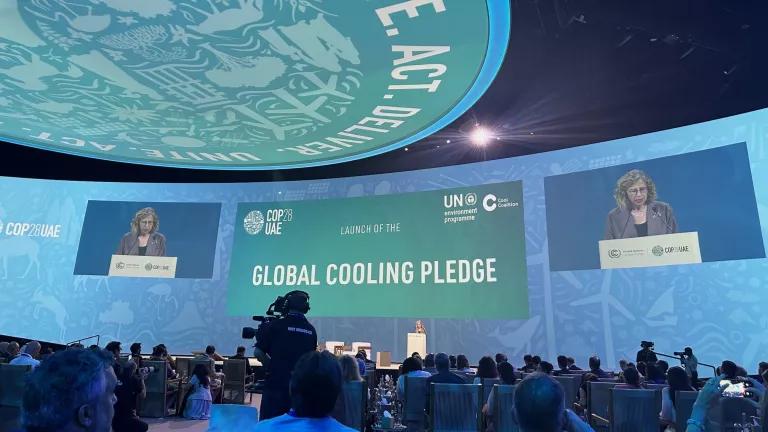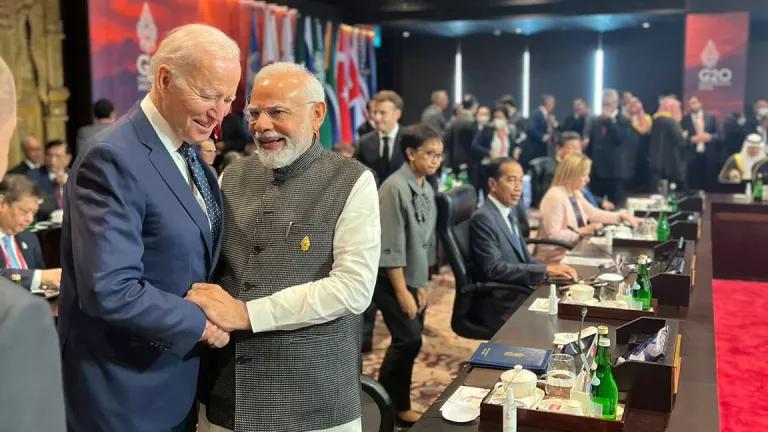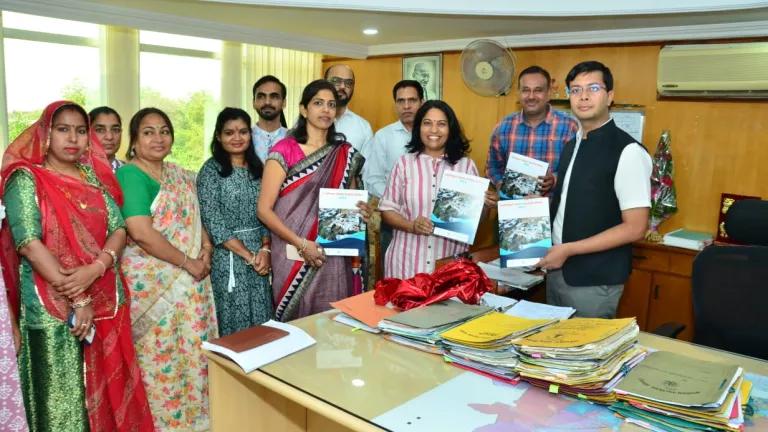
Co-Authored with Amartya Awasthi, Bhaskar Deol and Alex Hillbrand
With Earth Day top of mind this week, what do you think is one of the top strategies to protect the planet from climate change? Would you guess improving air conditioners? That’s true for India and the earth.
With rising income levels in India, and climate change fueling temperatures higher, the demand for air conditioners is increasing. Mumbai already hit a scorching 41˚C (105.8˚F), marking the hottest March day in seven years.
Less than 10 percent of Indian households currently use air conditioners, but sales are increasing by 10 to 15 percent every year as income levels rise. There’s no one-size-fits-all solution that can keep 1.3 billion people—many who lack a reliable supply of electricity—cool, without adding to the burden of air pollution and ramping up the climate pollution that is making the heat worse.
The stock of room air conditioners has skyrocketed from 2 million units in 2006 to approximately 30 million units in 2017. These units burden electric grids with greater peak power demand, leading to higher power plant fuel consumption and increasingly poor air quality. Increased air conditioner use also exacerbates harmful climate change caused by emissions of carbon dioxide from power generation and the release of refrigerants, usually hydrofluorocarbons (HFCs), potent heat trapping gases used in air conditioners.
To beat the heat without harming the environment, India is looking at a combination of strategies, including climate-friendly air conditioners, cool roofs and energy efficient buildings. The Energy and Resources Institute, Natural Resources Defense Council, and the Institute for Governance and Sustainable Development have partnered together to examine strategies to improve air conditioning in our new report: Cooling India With Less Warming: Affordable and Efficient Room Air Conditioners.

“This report addresses how to meet the rising room AC cooling demand in a sustainable manner, through smart policies that promote an accelerated transition towards climate-friendly and energy efficient air conditioner technologies. The report also examines adoption of more ambitious standards and labels to create awareness around climate friendly refrigerants or measures to reduce the cooling demand.”
- Dr. Ajay Mathur, TERI
The Opportunity: Improving Air Conditioning
Both in terms of the refrigerant greenhouse gases and energy efficiency – improving air conditioners offers major benefits. Leading AC manufacturers recognize the tremendous business opportunity and are aggressively working to increase market share. In October 2016, 197 countries reached a historic agreement, the Kigali Amendment to the Montreal Protocol, to cap and then phase down production and consumption of HFCs worldwide. HFCs have a thousand times higher global warming potential than carbon dioxide, and phasing down HFCs is one of the greatest opportunities to stave off the worst effects of climate change.
The benefits of improved ACs are huge. In India alone, fulfilling the Kigali Amendment is expected to avoid the use of HFCs equivalent to between 2 and 6 billion tons of carbon dioxide through 2050 – about 20 to 25% of which is likely to come from reductions in HFCs used for room ACs. India has an opportunity to avoid an additional 950 million tons of HFC use through 2050, by phasing down faster, on pace with the majority of developing countries under the Kigali agreement. Air conditioning manufacturers in India already offer ACs using refrigerants such as low global warming potential (GWP) hydrocarbon HC-290 (propane), with GWP 3, and transitional refrigerant HFC-32, with GWP 677, compared to the refrigerants HCFC-22 with GWP 1760 and HFC-410A with GWP 1924.

“Keeping cool in India is not just a matter of comfort. It's a matter of life and death. This report offers key strategies to transform the air conditioning market to tackle global climate change while providing much needed cooling to billions. The market for air conditioners is growing fast in South Asia and this type of smart planning is crucial to our future.”
- Frances Beinecke, NRDC
In addition to switching to better refrigerants, improving the energy efficiency of room ACs can deliver even more remarkable climate benefits. Lawrence Berkeley National Laboratory estimates that if by 2030, India’s AC stock improves in average efficiency by 30% from 2015 levels, annual carbon dioxide emissions will decrease by approximately 180 million metric tons per year - equivalent to about 10% of the carbon dioxide emissions reductions expected from India’s Nationally Determined Contribution (NDC) to the Paris Agreement in that year.
More than 50 room AC models that meet the climate-friendly LBNL scenario – having Indian Seasonal Energy Efficiency Ratios (ISEERs) of 4.0 or greater – are already on the Indian market. These energy efficient ACs include several using low-GWP refrigerant HC-290 (up to 1.5 tons) and lower-GWP HFC-32 (up to 1.8 tons). The best room ACs as of April 2018 have already reached ISEER 5.8 and upwards in the Indian market, sold by Daikin, Godrej, Panasonic, LG and Hitachi. Yet, more needs to be done to advance markets that improve air conditioning.
Energy efficient and climate-friendly room ACs are just part of the solution. Passive cooling techniques, such as using shading, ventilation, and cool roofs, homes built to energy conservation building codes, and adaptive thermal comfort strategies, will lessen dependence on mechanical cooling, saving energy and reducing pollution even before the AC turns on.
Six Strategies for Improving Air Conditioning
The issue brief identifies six strategies with varying ease of implementation to advance climate-friendly ACs in India and globally. Some strategies are already underway – such as energy efficiency standards, bulk procurement programs, and national cooling action plans – but may benefit from higher ambition or better integration. Other strategies require longer timeframes, such as localizing supply chains and raising consumer awareness. Some strategies call for government leadership while others rely on industry leadership.
- Opportunities under the Montreal Protocol. Room AC manufacturers phasing out HCFC-22 should continue leapfrogging traditional high-GWP HFCs in favor of the lower-GWP alternatives with funding support from the Montreal Protocol while also working with UN agencies to facilitate co-funding and/or financing energy efficiency upgrades.
- Energy Efficiency and Low-GWP Standards & Labels. The Bureau of Energy Efficiency Star Labeling program has succeeded in strengthening AC efficiency standards and labels by about 35% since 2006, representing major cost and energy savings in India. One immediate opportunity, consistent with the number of efficient room ACs entering the market in India, is to consider advancing the rate at which the Star Rating program is strengthened to foster competition and help consumers identify the most efficient room ACs.
- Bulk Procurement Programs. Bulk procurement programs, such as EESL’s AC program, are revolutionizing the landscape for high efficiency products, and a strategy to advance efficiency is encouraging lower-GWP refrigerants as part of the procurement process.
- Raising Consumer Awareness. Differentiating among room ACs with stronger efficiency standards, above ISEER 4.5, would help consumers identify the most energy efficient room ACs as well as including GWP-based refrigerant labels to the Star Rating program.
- Local Supply Chains and R&D. Leveraging programs such as “Make in India,” the AC industry can work with the Indian government to increase domestic components used in room ACs, as well as, financial incentives for high-efficiency components and private buyers clubs.
- National Cooling Action Plans. India is developing a National Cooling Action Plan that brings cooling strategies together from more efficient AC designed, low-GWP refrigerants, and passive cooling technologies.

“I am incredibly impressed at how fast after Kigali the Indian government, industry and NGOs have come together to promote affordable super-efficient ACs using lower-GWP refrigerants. Air conditioning manufacturers in India are an engineering center of excellence in the application of both natural R-290 and less-flammable R-32 refrigerants and the government's Energy Efficiency Services Limited (EESL) is the global pioneer in using buyers clubs to make super-efficiency affordable.”
- Dr. Stephen O. Andersen, IGSD
While policies like the Kigali Amendment, strengthened energy efficiency standards and nascent bulk procurement programs have spurred progress, it is ultimately the industry that has delivered the technical innovations that have resulted in ground-breaking room ACs reaching the Indian market. In identifying the strategies in this report, we have sought to work with various stakeholders to identify ways to accelerate the AC market transformation already underway in India and elsewhere.
While many of these strategies are already in use, greater ambition and better integration can still make a big difference to meet the growing cooling demand from an onslaught of climate change and rising temperatures so that with both adaptive and mitigation strategies thermal comfort for all can be realized in a climate friendly and sustainable manner.
The issue brief, Cooling India With Less Warming: Affordable and Efficient Room Air Conditioners, is available here: https://www.nrdc.org/resources/cooling-india-less-warming
This blog was updated to discuss the technical specifics between AC stock and sales. As discussed in the issue brief, while AC sales are growing rapidly, the AC installed stock (the total number of ACs in use in homes and commercial buildings) has skyrocketed from 2 million units in 2006 to nearly 30 million units in 2017, and is growing every year with increasing sales. Indians bought about 5 million ACs last year, and with forecasts for a hot 2018, manufacturers expect another year with high sales.



